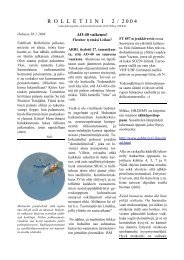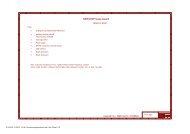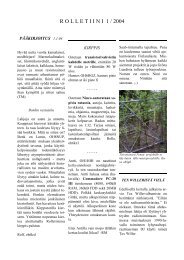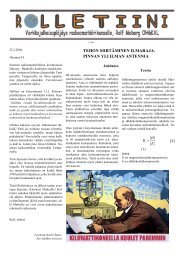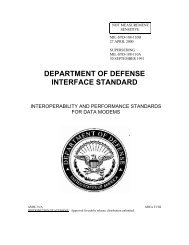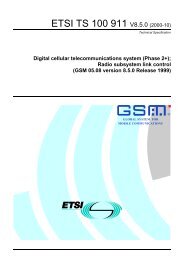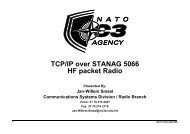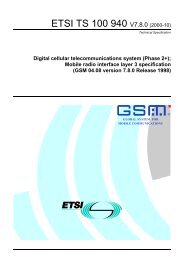nato unclassified - Ham-pages ... No indexes at this level
nato unclassified - Ham-pages ... No indexes at this level
nato unclassified - Ham-pages ... No indexes at this level
Create successful ePaper yourself
Turn your PDF publications into a flip-book with our unique Google optimized e-Paper software.
NATO UNCLASSIFIED<br />
STANAG 5066: PROFILE FOR MARITIME HF DATA COMMUNICATION<br />
V1.0.2<br />
Destin<strong>at</strong>ion <strong>No</strong>de Address, Destin<strong>at</strong>ion SAP ID,<br />
Priority, U_PDU)<br />
S_DATA_FLOW_ON( )<br />
S_DATA_FLOW_OFF ( )<br />
S_MANAGEMNT _MSG_REQUEST (MSG)<br />
S_MANAGEMENT_MSG_INDICATION<br />
(MSG)<br />
S_KEEP_ALIVE ( ) S_KEEP_ALIVE ( )<br />
The description of the primitives follows:<br />
Name :<br />
S_BIND_REQUEST ( )<br />
Arguments :<br />
1. Service Type,<br />
2. RANK,<br />
3. SAP ID<br />
Direction :<br />
Client -> Subnetwork Interface<br />
Description :<br />
This primitive must be issued by a new client when it first connects to the<br />
subnetwork. Unless <strong>this</strong> primitive is issued the client can not be serviced. With <strong>this</strong><br />
primitive the client uniquely identifies itself and declares th<strong>at</strong> it is “on-line” and<br />
ready to be serviced by the subnetwork. The first argument of <strong>this</strong> primitive is<br />
“Service Type” and identifies the default type of service requested by the client. This<br />
service type will apply to all d<strong>at</strong>a units submitted by the client unless explicitly<br />
overridden (see S_UNIDATA_REQUEST primitive). The “Service Type” argument<br />
is a complex argument and has a number of <strong>at</strong>tributes. The second argument of <strong>this</strong><br />
primitive is “Rank”. This is a measure of the importance of a client; itis used by the<br />
subnetwork to alloc<strong>at</strong>e resources. A detailed description of the Service Type<br />
argument is given <strong>at</strong> the end of <strong>this</strong> section. A description of the use of the Rank<br />
argument may be found in Annex H and [1]. The range of possible rank arguments is<br />
from 0 to 15. Clients which are not authorised to make changes to a node or<br />
subnetwork configur<strong>at</strong>ion shall not bind with rank of 15. The third argument of <strong>this</strong><br />
primitive is the “SAP ID” which the client wishes to be assigned. The SAP ID must<br />
be node <strong>level</strong> unique, i.e. not assigned to another connected client.<br />
Name :<br />
S_UNBIND_REQUEST ( )<br />
Arguments :<br />
NONE<br />
Direction :<br />
client -> Subnetwork Interface ( )<br />
Description :<br />
This primitive is issued by a client in order to declare itself as “off-line”. Going offline<br />
results in the release of the SAP ID of <strong>this</strong> client which can be alloc<strong>at</strong>ed to<br />
another client th<strong>at</strong> may request it. A client which went off-line by issuing <strong>this</strong><br />
primitive can come on-line again by issuing a new S_BIND_REQUEST. A client can<br />
also go off-line by physically disconnecting itself (e.g. powering down the computer<br />
which runs the client program) or disconnecting the physical cable (RS232, Ethernet,<br />
NATO UNCLASSIFIED<br />
4




